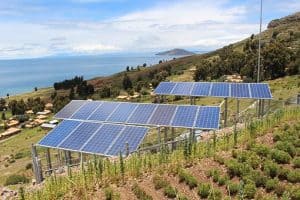[fusion_builder_container hundred_percent=”yes” overflow=”visible”][fusion_builder_row][fusion_builder_column type=”1_1″ background_position=”left top” background_color=”” border_size=”” border_color=”” border_style=”solid” spacing=”yes” background_image=”” background_repeat=”no-repeat” padding=”” margin_top=”0px” margin_bottom=”0px” class=”” id=”” animation_type=”” animation_speed=”0.3″ animation_direction=”left” hide_on_mobile=”no” center_content=”no” min_height=”none”]
:
Huffington Post
23 October 2012
Earlier this month, federal officials streamlined the development of centralized, large-scale, solar power plants by establishing 17 new “solar energy zones” on 285,000 acres of public land. According to Steven Chu, the U.S. Secretary of Energy, this cutting of red tape will expand solar energy production and help the nation remain competitive in the global clean energy race. While this move marks a step in the right direction, an integral piece of the puzzle is still missing. Policymakers must also streamline the development of local energy, known as distributed generation (DG).
The role of DG in the global renewable energy market is rapidly growing. In fact, Germany’s solar market — the world’s largest — is dominated by DG. Of all Germany’s solar capacity, which is large enough to meet half the country’s midday energy needs, 80 percent is on rooftops. DG, not large-scale generation, is powering Germany’s solar success. Streamlining DG in the United States, which boasts significantly stronger renewable resources than Germany, will put the nation on a path towards lasting energy independence.
Furthermore, DG beats out centralized generation on the very selection criteria used to identify the 17 newly selected solar zones — proximity to existing transmission infrastructure and minimizing environmental impacts. DG facilities have no need for transmission infrastructure, since they connect directly to the distribution grid, close to where energy is used. This avoids exorbitant costs associated with the long-distance transmission of energy, which can comprise nearly 25 percent of the total price a consumer pays for energy. Also, since DG facilities are built on underused urban spaces and previously degraded land — such as parking lots, rooftops and abandoned industrial sites — distributed generation protects America’s pristine environments.
Despite the clear benefits of DG, utilities have been reluctant to embrace local generation and substantial barriers still impede the development of DG. Lengthy and complex processes await anyone interested in generating clean local energy. A recent Forbes article declared that the installation costs of clean local energy systems could be reduced up to 50 percent simply by eliminating excessive paperwork. Germany has made great strides in streamlining the process of bringing clean local energy online, making their solar market decidedly more efficient than the U.S. solar market. According to research from Lawrence Berkeley National Laboratory, a similarly streamlined market in California could bring rooftop solar online at a cost of seven to 10 cents/kWh, depending on project size. Instead, California’s market remains prohibitively complex, and no solar project has ever delivered energy at such a low price. Therefore, the creation of a simple, standardized and fair contract for use between utilities and DG energy generators is a critical step towards streamlining the development of clean local energy.
Right now, the California Public Utilities Commission is in the process of finalizing a “standard form contract” power purchase agreement (PPA), which California’s investor owned utilities (IOUs) — like PG&E, SCE, and SDG&E — must use when purchasing energy from distributed generation facilities. Predictably, the IOUs have proposed a PPA that is five times longer and more complex than a comparable PPA used by leading municipal utilities in California like Sacramento Municipal Utility District and Palo Alto Utilities. Unnecessary and complicated requirements in the IOUs’ proposed PPA would undoubtedly add significant costs and further hinder the development of clean local energy in the state.
Alternatively, the Clean Coalition has proposed a “model PPA” that is fair, simple, and transparent. This model PPA will reduce the costs and timelines associated with bringing clean local energy online, while also saving consumers money by eliminating unnecessary transaction costs and unleashing competition in the energy marketplace. Moreover, the Clean Coalition’s model PPA is highly aligned with supporting Governor Brown’s goal of deploying 12,000 megawatts (MW) of distributed renewable energy in California by the end of 2020, and diverse groups — such as the California Solar Energy Industries Association (CALSEIA), Sierra Club California, Agricultural Energy Consumers Association (AECA) and Placer County — all support the adoption of the model PPA.
Once adopted in California, the model PPA will serve as a standard that states and utilities across the country can use to streamline and boost the development of distributed generation — a vital step to being competitive in the global clean energy race.
Follow Craig Lewis and the Clean Coalition on Twitter @Clean_Coalition.[/fusion_builder_column][/fusion_builder_row][/fusion_builder_container]

Leave a Reply